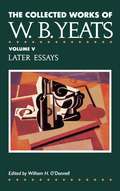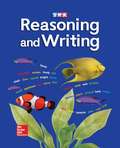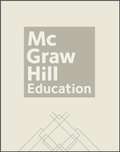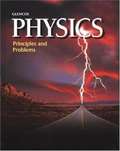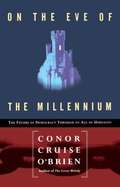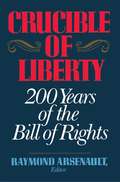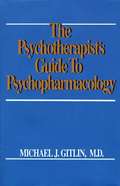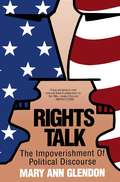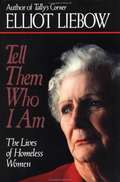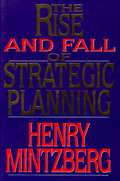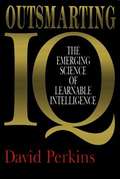- Table View
- List View
SpotlightTM on Music [Grade 4]
by Judy Bond Margaret Campbelle-Holman René BoyerNIMAC-sourced textbook
SpotlightTM on Music [Grade 5]
by Judy Bond Margaret Campbelle-Holman René BoyerNIMAC-sourced textbook
SpotlightTM on Music [Grade 6]
by Judy Bond Margaret Campbelle-Holman René BoyerNIMAC-sourced textbook
The Collected Works of W. B. Yeats Volume V: Later Essays
by William Butler YeatsCompiling nineteen essays and introductions, a volume with explanatory notes includes Per Amica Silentia Lunae and On the Boiler as well as introductions on Shelley and Balzac and essays on Irish poetry and politics.
SRA Decoding Strategies, Decoding C, Enrichment Blackline Masters
by Siegfried Engelmann Owen EngelmannNIMAC-sourced textbook
Textbook, Level C [Grade 2]
by Jerry Silbert Siegfried EngelmannTo write well, students must be able to think well. With Reasoning and Writing, higher-level thinking is integrated with writing instruction to help students express ideas efficiently and effectively. Reasoning and Writing teaches: Analysis and logic to improve the ways students receive and convey information Thinking and reasoning skills necessary for critical reading Grammar, usage, and mechanics skills required for clear communication Skills essential for developing complete, effective sentences and for writing strong paragraphs
Fortunately
by Remy CharlipGood and bad luck accompany Ned from New York to Florida on his way to a surprise party. Images and image descriptions available.
The Surprise Party (Mini Treasure)
by Pat Hutchins"I'm having a party tomorrow," Rabbit whispers to Owl. "It's a surprise." But Owl tell the news to Squirrel, he says, "Rabbit is hoeing the parsley tomorrow. It's a surprise." By the time word has spread to all of Rabbit's friends, it's anyone's guess just what it is that Rabbit will be doing tomorrow!
Physics: Principles and Problems (Physics:princ And Problems Ser.)
by Paul W. ZitzewitzScience textbook for high school students.
Physics: Principles and Problems, Laboratory Manual, Student Edition
by Glencoe Mcgraw-HillThe Laboratory Manual contains 53 experiments for the beginning student of physics. The experiments illustrate the concepts found in this introductory course. Both qualitative and quantitative experiments are included, requiring manipulation of apparatus, observation, and collection of data. The experiments are designed to help you utilize the processes of science to interpret data and draw conclusions.
2 Daniel Silva Books: The New Girl and The Rembrandt Affair
by Daniel SilvaTHE NEW GIRL: At an exclusive private school in Switzerland, mystery surrounds the identity of the beautiful girl who arrives each morning and leaves each afternoon in a heavily protected motorcade fit for a head of state. She is said to be the daughter of a wealthy international businessman. She is not. And when she is brutally kidnapped across the border in the Haute-Savoie region of France, Gabriel all on, the legendary chief of Israeli intelligence, is thrust into a deadly secret war with an old enemy that will determine the future of the Middle east and perhaps the world. THE REMBRANDT AFFAIR: Having retreated to the windswept cliffs of Cornwall with his beautiful wife, Gabriel Allon's seclusion is interrupted by an eccentric London art dealer with a problem. An art restorer has been brutally murdered and a portrait by Rembrandt stolen—and only Gabriel can find it. But as he pursues the masterpiece across the globe, Gabriel discovers there are deadly secrets connected to the painting—and even deadlier men who will do anything to keep them.
On the Eve of the Millennium: The Future of Democracy Through an Age of Unreason
by Conor Cruise O’brien"All my life," writes Conor Cruise O'Brien, "I have been fascinated and puzzled by nationalism and religion; by the interaction of the two forces, sometimes in unison, sometimes antagonistic." In these wide-ranging and penetrating essays, O'Brien examines how throughout the world today these age-old forces are once again threatening democracy, the rule of law, and freedom of expression -- particularly in the United States, the nation founded on Enlightenment values. He weaves together beautifully written discussions on these and other timely, related topics. Enlivening his grim predictions with dry wit, he nevertheless conveys an apocalyptic sense of the threats facing democracy as we approach the third millennium.
Crucible of Liberty: 200 Years of the Bill of Rights
by Raymond ArsenaultThe adoption of the Bill of Rights in 1791 marked the creation of a uniquely innovative mechanism for constitutional change by which Americans have continued to renew and redefine their governance over a two-hundred-year period. Now, in time for the bicentennial celebration of this great document, seven distinguished scholars combine their expertise to explore the history and contemporary meaning of these first ten amendments to the Constitution.
The Psychotherapist’s Guide to Psychopharmacology
by Michael J. GitlinGitlin (psychiatry, UCLA) provides a guide to medicines used for treating mental and emotional disorders, designed to familiarize mental health professionals who do not prescribe medicine with the latest medical treatment options. He describes the type of treatment used for numerous disorders, explaining in detail how each medication works and its effects.
Rights Talk: The Impoverishment of Political Discourse
by Mary Ann GlendonHow America has created an ever-expanding list of rights while leaving behind the duties and responsibilities of citizens in the process.
Service Breakthroughs
by James L. Heskett W. Earl Sasser Christopher W. L. Hart Jr.What Do Citicorp, UPS and Marriott have in common? They are "breakthrough" service providers,firms that changed the rules of the game in their respective industries by consistently meeting or exceeding customer needs and expectations. To find out how these companies do it, service management experts James Heskett, Earl Sasser, and Christopher Hart put the question to the chief executive officers of fifteen of America's leading service firms attending a workshop at the Harvard Business School. Breakthrough leaders, they discovered, think very differently about their businesses than do their competitors, in distinct and well-defined ways. Now, in Service Breakthroughs, based upon five years of exhaustive research in fourteen service industries, Heskett, Sasser, and Hart show exactly what enables one or two companies in each industry to constantly set new standards for quality and value that force competitors to adapt or fail. At the heart of breakthrough performance, the authors contend, is a sometimes intuitive but thorough understanding of the "self-reinforcing service cycle" that replaces traditional management of "trade-offs." The "cycle" is a paradigm derived from the research results suggesting direct links between heightened customer satisfaction, increased customer retention, augmented sales and profit, improved quality and productivity, greater service value per unit of cost, improved satisfaction of service providers, increased employee retention, and further heightened customer satisfaction. With detailed examples and dramatic case studies of Mark Twain Bancshares, American Airlines, Florida Power & Light, Federal Express, McDonald's and many other companies, Heskett, Sasser, and Hart show how this self-reinforcing cycle of behavior differentiates breakthrough leaders from their "merely good" competitors. The authors describe how breakthrough managers develop counter-intuitive, even contrarian, strategic service visions. These companies define their "service concept" in terms of results achieved for customers rather than services performed. They target market segments by focusing on psychographics -- how customers think and behave -- instead of demographics. And instead of viewing a service delivery system as a facility where the service is produced and sold, breakthrough firms see it as an opportunity to enhance the quality of the service. These profound differences in thought and action have brought spectacular results. For managers who wish to set the pace in their service industries, Service Breakthroughs will be essential reading.
Tell Them Who I Am: The Lives of Homeless Wome
by Elliot LiebowLiebow observes them, creating portraits that are intimate and objective, while breaking down stereotypes and dehumanizing labels often used to describe the homeless. Liebow writes about their daily habits, constant struggles, their humor, compassion and strength.-- National syndicated radio interview.
Embattled Courage: The Experience of Combat in the American Civil War
by Gerald F. LindermanLinderman traces each soldier's path from the exhilaration of enlistment to the disillusionment of battle to postwar alienation. He provides a rare glimpse of the personal battle that raged within soldiers then and now.
The Rise and Fall of Strategic Planning
by Henry MintzbergIn this definitive and revealing history, Henry Mintzberg, the iconoclastic former president of the Strategic Management Society, unmasks the press that has mesmerized so many organizations since 1965: strategic planning. One of our most brilliant and original management thinkers, Mintzberg concludes that the term is an oxymoron -- that strategy cannot be planned because planning is about analysis and strategy is about synthesis. That is why, he asserts, the process has failed so often and so dramatically. Mintzberg traces the origins and history of strategic planning through its prominence and subsequent fall. He argues that we must reconceive the process by which strategies are created -- by emphasizing informal learning and personal vision -- and the roles that can be played by planners. Mintzberg proposes new and unusual definitions of planning and strategy, and examines in novel and insightful ways the various models of strategic planning and the evidence of why they failed. Reviewing the so-called "pitfalls" of planning, he shows how the process itself can destroy commitment, narrow a company's vision, discourage change, and breed an atmosphere of politics. In a harsh critique of many sacred cows, he describes three basic fallacies of the process -- that discontinuities can be predicted, that strategists can be detached from the operations of the organization, and that the process of strategy-making itself can be formalized. Mintzberg devotes a substantial section to the new role for planning, plans, and planners, not inside the strategy-making process, but in support of it, providing some of its inputs and sometimes programming its outputs as well as encouraging strategic thinking in general. This book is required reading for anyone in an organization who is influenced by the planning or the strategy-making processes.
Outsmarting IQ: The Emerging Science of Learnable Intelligence
by David PerkinsSince the turn of the century, the idea that intellectual capacity is fixed has been generally accepted. But increasingly, psychologists, educators, and others have come to challenge this premise. Outsmarting IQ reveals how earlier discoveries about IQ, together with recent research, show that intelligence is not genetically fixed. Intelligence can be taught. David Perkins, renowned for his research on thinking, learning, and education, identifies three distinct kinds of intelligence: the fixed neurological intelligence linked to IQ tests; the specialized knowledge and experience that individuals acquire over time; and reflective intelligence, the ability to become aware of one's mental habits and transcend limited patterns of thinking. Although all of these forms of intelligence function simultaneously, it is reflective intelligence, Perkins shows, that affords the best opportunity to amplify human intellect. This is the kind of intelligence that helps us to make wise personal decisions, solve challenging technical problems, find creative ideas, and learn complex topics in mathematics, the sciences, management, and other areas. It is the kind of intelligence most needed in an increasingly competitive and complicated world. Using his own pathbreaking research at Harvard and a rich array of other sources, Perkins paints a compelling picture of the skills and attitudes underlying learnable intelligence. He identifies typical pitfalls in multiple perspectives, and neglecting evidence. He reveals the underlying mechanisms of intelligent behavior. And he explores new frontiers in the development of intelligence in education, business, and other settings. This book will be of interest to people who have a personal or professional stake in increasing their intellectual skills, to those who look toward better education and a more thoughtful society, and not least to those who follow today's heated debates about the nature of intelligence.
The Logistics Handbook
by James F. Robeson William C. Copacino R. Edwin HoweThe Logistics Handbook encompasses all of the latest advances in warehousing and distribution. It provides invaluable "how to" problem-solving tools and techniques for all the ever-increasing logistical problems managers face -- making it the most complete and authoritative handbook to date. Special features include:* The most in-depth coverage of a wide range of topics, including information systems, benchmarking, and environmental issues* Contributions found nowhere else from the leading executives, consultants, and academics in the field, such as C. John Langley, James Heskett, and David Anderson* State of the art graphics* Information-packed appendixes of logistics publications and organizationsThis all-inclusive reference will enable the next generation of managers to thoroughly integrate their logistics operations at all levels -- strategic, structural, functional, and implementation -- into a comprehensive logistics strategy.

